Archived Article Detail
By Thomas P. Moore
WHAT’S NEW IN THE MINERAL WORLD ARCHIVE – posted on 7/21/2007
Here in Tucson we’ve recently had our 30th day in a row with daily highs in excess of 100 degrees F. On such days even the lizards curl up under rocks—and I, for my part, curled up in my shady office, have compiled the following look at what’s mineralogically new on the web. The Internet can be a cool enough place to hang out in July…
The Philadelphia Collection at Collector’s Edge
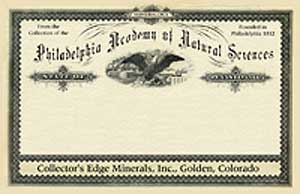 Confusions, excitements, conflicting agendas and overstressed nerves as regards the venerable mineral collection of the Philadelphia Academy of Natural Sciences have been prominent in the news for the past several months—if you want a review of what it is all about, see Wendell Wilson’s editorial in the Nov.-Dec. 2006 issue (also shown in Axis on this website). As is generally known by now, the bulk of the Philadelphia collection was sold last fall to a dealer consortium consisting of Bryan Lees’ Collector’s Edge, Wayne and Dona Leicht’s Kristalle and Ian Bruce’s Crystal Classics, and meanwhile, last December, a court hearing was held to determine the disposition of the 19th-century William S. Vaux collection, the illustrious core of the Academy’s mineralogical holdings.
Confusions, excitements, conflicting agendas and overstressed nerves as regards the venerable mineral collection of the Philadelphia Academy of Natural Sciences have been prominent in the news for the past several months—if you want a review of what it is all about, see Wendell Wilson’s editorial in the Nov.-Dec. 2006 issue (also shown in Axis on this website). As is generally known by now, the bulk of the Philadelphia collection was sold last fall to a dealer consortium consisting of Bryan Lees’ Collector’s Edge, Wayne and Dona Leicht’s Kristalle and Ian Bruce’s Crystal Classics, and meanwhile, last December, a court hearing was held to determine the disposition of the 19th-century William S. Vaux collection, the illustrious core of the Academy’s mineralogical holdings.
The problem was that for about four decades now the Philadelphia minerals, including the Vaux collection, have not been properly displayed or curated, or even protected adequately against pilfering. It could be (and was) argued that the Academy had betrayed the trust which had come, long ago, with the Vaux bequest, and now it was time that the specimens be brought to light again via the open market. Well, a very recent Philadelphia Inquirer story reports that the Academy, somewhere around the time of the court hearing, decided that it wanted to keep the Vaux collection after all, and that this time it would be willing to care for it. The judge acceded, and now, to quote the Inquirer story, “Mineral enthusiasts hoping to get a few pieces of [the] Vaux mineral collection can put away their checkbooks.” Ned Gilmore of the Academy will be the collection manager, and Ted Daeschler—also of the Academy, and by background a paleontologist—will be Associate Curator. Thus we await with some trepidation whatever will happen further at the stately old museum building on Logan Square, where as a teenager I used to haunt the public mineral display as it then existed and soon would exist no more.
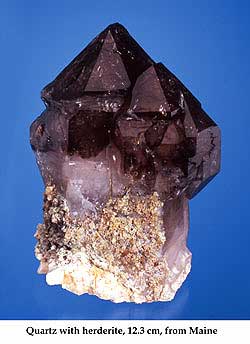 The good news is that collectors will very soon have a chance to pick from the hoard of non-Vaux specimens which have been cleaned and prepped for market, and even, after all, from a small number of specimens which did belong to William S. Vaux—those which he donated while he was an active collector and which therefore are not subject to the restrictions placed on his later bequest. I have no special information about how the other two dealerships intend to handle their new/antique specimens from Philadelphia, but the Collector’s Edge people tell me that they will be offering many first-rate pieces for sale at the upcoming Denver Show. The accumulation which Collector’s Edge hauled from Philadelphia to Golden, Colorado last fall totaled 1,758 standard-size flats full of mineral specimens; of these, 426 flats contained specimens from Pennsylvania, while in distant second and third place respectively were the United Kingdom (102 flats) and Germany (72 flats). Ian Bruce (naturally) has taken over the bulk of the British specimens, Wayne and Dona Leicht have taken large numbers of miscellaneous pieces, and some locality suites have already gone to appropriate regional museums—with all of the vast Pennsylvania hoard staying in-state by going to the Carnegie Museum in Pittsburgh. In those 1,758 flats, the great majority of the material consists of “reference,” including “interesting extinct locality,” pieces, and real killers constitute just a small percentage. But, having visited the warehouse in Golden and spent most of a day there looking into the flats, and having seen, on the same trip, some quite incredible things which had already made it into the main Collector’s Edge facilities, I know that Denver showgoers will have an enormous treat to look forward to. For teaser pictures, see the Collector’s Edge ad in the just-mailed July-August issue, and see the two Philly old-timers shown here: a deeply colored Maine amethyst and an enormous, resplendent Peruvian gratonite. Wendell Wilson designed the old-timery-looking label: customers will receive one of these with each purchase of a Philly specimen.
The good news is that collectors will very soon have a chance to pick from the hoard of non-Vaux specimens which have been cleaned and prepped for market, and even, after all, from a small number of specimens which did belong to William S. Vaux—those which he donated while he was an active collector and which therefore are not subject to the restrictions placed on his later bequest. I have no special information about how the other two dealerships intend to handle their new/antique specimens from Philadelphia, but the Collector’s Edge people tell me that they will be offering many first-rate pieces for sale at the upcoming Denver Show. The accumulation which Collector’s Edge hauled from Philadelphia to Golden, Colorado last fall totaled 1,758 standard-size flats full of mineral specimens; of these, 426 flats contained specimens from Pennsylvania, while in distant second and third place respectively were the United Kingdom (102 flats) and Germany (72 flats). Ian Bruce (naturally) has taken over the bulk of the British specimens, Wayne and Dona Leicht have taken large numbers of miscellaneous pieces, and some locality suites have already gone to appropriate regional museums—with all of the vast Pennsylvania hoard staying in-state by going to the Carnegie Museum in Pittsburgh. In those 1,758 flats, the great majority of the material consists of “reference,” including “interesting extinct locality,” pieces, and real killers constitute just a small percentage. But, having visited the warehouse in Golden and spent most of a day there looking into the flats, and having seen, on the same trip, some quite incredible things which had already made it into the main Collector’s Edge facilities, I know that Denver showgoers will have an enormous treat to look forward to. For teaser pictures, see the Collector’s Edge ad in the just-mailed July-August issue, and see the two Philly old-timers shown here: a deeply colored Maine amethyst and an enormous, resplendent Peruvian gratonite. Wendell Wilson designed the old-timery-looking label: customers will receive one of these with each purchase of a Philly specimen.
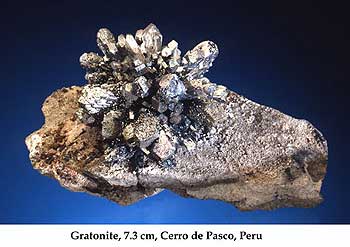 Denver 2007 should be, in fact, a peak experience for Collector’s Edge and its clientele. Besides the Philadelphia things, the dealership will have some new gold specimens from the Mockingbird mine, California, to supplement the extraordinary suite of such specimens unveiled at Tucson 2007, and some new golds from the Round Mountain mine, Nevada. Fine pieces from the former Roz and Norm Pellman collection still remain on the shelves, and there are pretty representatives of a new discovery of creedite in Colorado—see later in this report. Finally, in June of this year the Collector’s Edge-Kristalle-Crystal Classics consortium acquired a collection of aesthetic cabinet-size specimens assembled by Dr. Stephen Neely of Lebanon, Tennessee: one of the top contemporary collectors, who, just in the 12 or so years I’ve known him, has already gathered and disposed of three mineral collections, including this one. Count on seeing the finest possible large examples of beryl from Pakistan, pyromorphite from France and Idaho and China, azurite from Tsumeb and Bisbee, world-class fluorite from everywhere…and, of course, more.
Denver 2007 should be, in fact, a peak experience for Collector’s Edge and its clientele. Besides the Philadelphia things, the dealership will have some new gold specimens from the Mockingbird mine, California, to supplement the extraordinary suite of such specimens unveiled at Tucson 2007, and some new golds from the Round Mountain mine, Nevada. Fine pieces from the former Roz and Norm Pellman collection still remain on the shelves, and there are pretty representatives of a new discovery of creedite in Colorado—see later in this report. Finally, in June of this year the Collector’s Edge-Kristalle-Crystal Classics consortium acquired a collection of aesthetic cabinet-size specimens assembled by Dr. Stephen Neely of Lebanon, Tennessee: one of the top contemporary collectors, who, just in the 12 or so years I’ve known him, has already gathered and disposed of three mineral collections, including this one. Count on seeing the finest possible large examples of beryl from Pakistan, pyromorphite from France and Idaho and China, azurite from Tsumeb and Bisbee, world-class fluorite from everywhere…and, of course, more.
On The Web
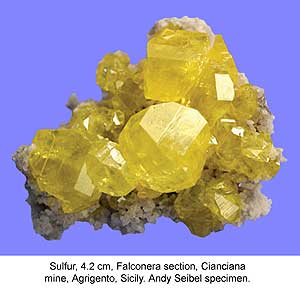 Time now for some serious web-browsing. Andy Seibel of California (www.andyseibel.com) reports that just after this summer’s Ste-Marie-aux-Mines Show he headed down to Sicily with Italian collector/dealer Giuseppe Agozzino, who had a line on some superb sulfur specimens recently found in the Falconera Section of the long-abandoned Cianciana mine. It’s a commonplace that Sicily Rules when it comes to crystallized native sulfur, but the old sulfur mines of the island, some of which date back to Roman times, have not produced much of note since the last commercial mining ceased in the mid-20th century. However, local collectors still brave some of the underground mines, where they have to deal with very unstable ground and very bad air: Andy reports that they typically go in with oxygen tanks so as not to pass out from the sulfurous vapors. Appreciate fully, then, the lovely specimens Andy brought back and now offers on his site: miniatures and small-cabinet pieces showing clean, exceptionally sharp sulfur crystals to more than 2 cm, perched singly and in little clusters on white aragonite matrix. These sulfur crystals are not only lustrous and morphologically exquisite; many are transparent, as can be readily seen in the pictures on Andy’s site. Therefore he hypes not when he says that “this fabulous offering is as good as it gets” for sulfur.
Time now for some serious web-browsing. Andy Seibel of California (www.andyseibel.com) reports that just after this summer’s Ste-Marie-aux-Mines Show he headed down to Sicily with Italian collector/dealer Giuseppe Agozzino, who had a line on some superb sulfur specimens recently found in the Falconera Section of the long-abandoned Cianciana mine. It’s a commonplace that Sicily Rules when it comes to crystallized native sulfur, but the old sulfur mines of the island, some of which date back to Roman times, have not produced much of note since the last commercial mining ceased in the mid-20th century. However, local collectors still brave some of the underground mines, where they have to deal with very unstable ground and very bad air: Andy reports that they typically go in with oxygen tanks so as not to pass out from the sulfurous vapors. Appreciate fully, then, the lovely specimens Andy brought back and now offers on his site: miniatures and small-cabinet pieces showing clean, exceptionally sharp sulfur crystals to more than 2 cm, perched singly and in little clusters on white aragonite matrix. These sulfur crystals are not only lustrous and morphologically exquisite; many are transparent, as can be readily seen in the pictures on Andy’s site. Therefore he hypes not when he says that “this fabulous offering is as good as it gets” for sulfur.
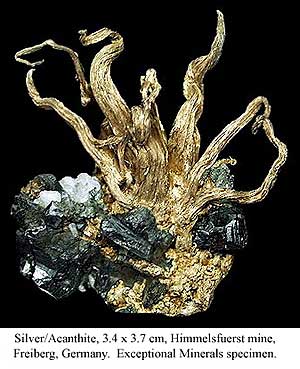 In an earlier online report I recommended the dazzling array of top-of-the-line specimens (mostly cabinet-size) to be found on the site of Kevin Ward’s Exceptional Minerals (www.exceptionalminerals.com), and scrolling down his selections is still a pretty exciting experience. The assortment is eclectic, although it does reflect Kevin’s personal bias in favor of silver and silver-essential minerals, and although a juicy smithsonite suite is included in the latest update. Among the standouts this time are a wonderful miniature of wire silver with acanthite crystals from the Himmelsfürst (“Prince of Heaven”) mine at Freiberg, in the former East Germany, and, much more surprisingly, a beautiful rhodochrosite which is also from the Himmelsfürst mine. I had not known, nor do any of my handy references make clear, that rhodochrosite of this type and quality was ever found in this renowned, long-extinct silver mine. As the picture shows, the specimen is a handsome one measuring 6 × 6.2 cm, with very sharp, pale pink, simple rhombohedrons of rhodochrosite in a deep vug in massive black alabandite.
In an earlier online report I recommended the dazzling array of top-of-the-line specimens (mostly cabinet-size) to be found on the site of Kevin Ward’s Exceptional Minerals (www.exceptionalminerals.com), and scrolling down his selections is still a pretty exciting experience. The assortment is eclectic, although it does reflect Kevin’s personal bias in favor of silver and silver-essential minerals, and although a juicy smithsonite suite is included in the latest update. Among the standouts this time are a wonderful miniature of wire silver with acanthite crystals from the Himmelsfürst (“Prince of Heaven”) mine at Freiberg, in the former East Germany, and, much more surprisingly, a beautiful rhodochrosite which is also from the Himmelsfürst mine. I had not known, nor do any of my handy references make clear, that rhodochrosite of this type and quality was ever found in this renowned, long-extinct silver mine. As the picture shows, the specimen is a handsome one measuring 6 × 6.2 cm, with very sharp, pale pink, simple rhombohedrons of rhodochrosite in a deep vug in massive black alabandite. 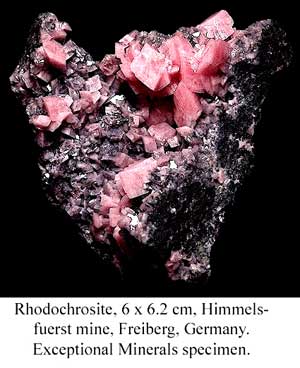 The Exceptional Minerals site is rich also in more recent things, including notably a superb large fluorite specimen from the White Rock quarry, Clay Center, Ohio. At the last Tucson Show, Dave Bunk had a hoard of cabinet-size fluorite and fluorite/celestine specimens from a November 2006 strike which, Dave said, had been Clay Center’s best in the last 50 years. Kevin’s site has several other Clay Center fluorites almost as fine as this one, encouraging the happy thought that in coming months we might run into still more, well, exceptional yellow-brown fluorites from this recent discovery.
The Exceptional Minerals site is rich also in more recent things, including notably a superb large fluorite specimen from the White Rock quarry, Clay Center, Ohio. At the last Tucson Show, Dave Bunk had a hoard of cabinet-size fluorite and fluorite/celestine specimens from a November 2006 strike which, Dave said, had been Clay Center’s best in the last 50 years. Kevin’s site has several other Clay Center fluorites almost as fine as this one, encouraging the happy thought that in coming months we might run into still more, well, exceptional yellow-brown fluorites from this recent discovery.
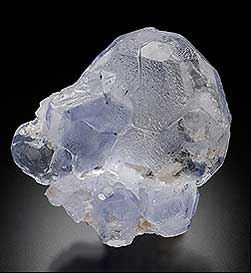 Another fluorite renaissance now ongoing is blessing us with gorgeous specimens from the Gibraltar mine in the famous Naica, Chihuahua, Mexico mining district. These, too, were on hand at the 2007 Tucson Show—the best were with Chris Wright of Wright’s Rock Shop—and ever-alert Rob Lavinsky apparently grabbed up a batch, so that there are many fine pieces on Rob’s Arkenstone site (www.irocks.com). Sharp, lustrous, transparent cuboctahedral crystals of fluorite to almost 5 cm perch smartly on lustrous black galena or sphalerite crystals. The fluorite ranges from colorless through palest purple to delicate apple-green. On a few of these specimens the really winning feature is that the fluorite crystals are utterly transparent on the cube faces but slightly frosted on the octahedron faces, so that you look through sharp-edged, square “windows” straight down to the black sulfide matrix. Some of the fluorites, too, have little pyrite crystal inclusions, and milky white calcite crystals decorate some of the pieces.
Another fluorite renaissance now ongoing is blessing us with gorgeous specimens from the Gibraltar mine in the famous Naica, Chihuahua, Mexico mining district. These, too, were on hand at the 2007 Tucson Show—the best were with Chris Wright of Wright’s Rock Shop—and ever-alert Rob Lavinsky apparently grabbed up a batch, so that there are many fine pieces on Rob’s Arkenstone site (www.irocks.com). Sharp, lustrous, transparent cuboctahedral crystals of fluorite to almost 5 cm perch smartly on lustrous black galena or sphalerite crystals. The fluorite ranges from colorless through palest purple to delicate apple-green. On a few of these specimens the really winning feature is that the fluorite crystals are utterly transparent on the cube faces but slightly frosted on the octahedron faces, so that you look through sharp-edged, square “windows” straight down to the black sulfide matrix. Some of the fluorites, too, have little pyrite crystal inclusions, and milky white calcite crystals decorate some of the pieces.
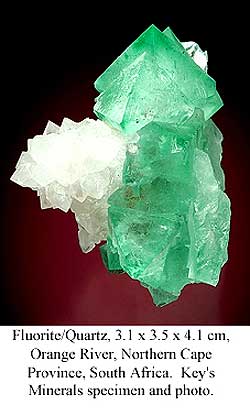 Finally (on the fluorite theme), Kiyoshi Kiikuni of Key’s Mineral Collection (www.keysminerals.com) once again has a beautiful website page consecrated to his own love of fluorite, and here you may see lovely things hailing from Cumbria, Cave-in-Rock, Naica, Dalnegorsk, etc.—but the most appealing to my taste are some clusters of transparent green octahedral crystals of fluorite on quartz crystals from the recently noted occurrence on the Orange River, Northern Cape Province, South Africa, with individual fluorite crystals to more than 2 cm on edge. Several other dealers are now handling these South African fluorites too, most notably African-minerals specialists Brice and Christophe Gobin (www.mineralsweb.com).
Finally (on the fluorite theme), Kiyoshi Kiikuni of Key’s Mineral Collection (www.keysminerals.com) once again has a beautiful website page consecrated to his own love of fluorite, and here you may see lovely things hailing from Cumbria, Cave-in-Rock, Naica, Dalnegorsk, etc.—but the most appealing to my taste are some clusters of transparent green octahedral crystals of fluorite on quartz crystals from the recently noted occurrence on the Orange River, Northern Cape Province, South Africa, with individual fluorite crystals to more than 2 cm on edge. Several other dealers are now handling these South African fluorites too, most notably African-minerals specialists Brice and Christophe Gobin (www.mineralsweb.com).
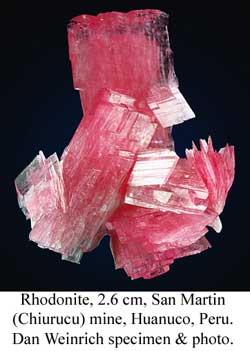 One of the biggest scoops of the 2007 Tucson Show was a lot of hundreds of variously sized specimens of rhodonite which had been found in October 2006 at the lead-zinc mine in Huanuco Department, Peru, once known as the Chiurucu mine, now renamed the San Martín mine—see the show report in the May-June issue. This new San Martín rhodonite of course closely resembles the older “Chiurucu” material marketed in 1989 and 1998, but in the high-elite contemporary pieces the very thin, transparent pink, bladed crystals of rhodonite fan out enough, i.e. are individualized enough, to make both for excruciating delicacy and stunning attractiveness. A late July update on Dan Weinrich’s website (wwwdanweinrich.com) offers about 10 of these beautiful items, thumbnail and small-miniature size, reportedly from an additional pocket discovery made after the time of the Tucson Show.
One of the biggest scoops of the 2007 Tucson Show was a lot of hundreds of variously sized specimens of rhodonite which had been found in October 2006 at the lead-zinc mine in Huanuco Department, Peru, once known as the Chiurucu mine, now renamed the San Martín mine—see the show report in the May-June issue. This new San Martín rhodonite of course closely resembles the older “Chiurucu” material marketed in 1989 and 1998, but in the high-elite contemporary pieces the very thin, transparent pink, bladed crystals of rhodonite fan out enough, i.e. are individualized enough, to make both for excruciating delicacy and stunning attractiveness. A late July update on Dan Weinrich’s website (wwwdanweinrich.com) offers about 10 of these beautiful items, thumbnail and small-miniature size, reportedly from an additional pocket discovery made after the time of the Tucson Show.
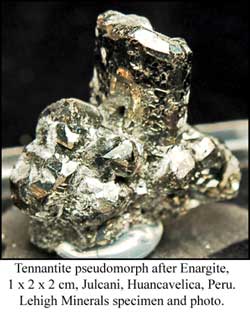 The Julcani mining district, Huancavelica, Peru is one of that country’s largest producers of silver and bismuth; mineral collectors know it chiefly for its outstanding specimens of bismuthinite, bournonite and enargite. Around the turn of the millennium there was a discovery of tennantite pseudomorphs after enargite at Julcani, the pseudocrystals averaging 2.5 cm but exceptionally reaching 7 cm. They are hollow epimorph (“mold”) pseudomorphs, with the lustrous metallic black tennantite shells quite sharply preserving the distinctive orthorhombic and flat-topped shape of the enargite; broken crystals show mealy black interiors where the alteration was still under way. These specimens have not been seen for a while on the market, but eight very nice ones now appear on the website of Lehigh Minerals (www.lehighminerals.com): they are mostly miniatures, one with sharp, platy white calcite crystals. The surfaces of most of the pseudocrystals are rendered somewhat rough and warty by later growths of tennantite, but the thumbnail specimen shown here is a very honorable exception.
The Julcani mining district, Huancavelica, Peru is one of that country’s largest producers of silver and bismuth; mineral collectors know it chiefly for its outstanding specimens of bismuthinite, bournonite and enargite. Around the turn of the millennium there was a discovery of tennantite pseudomorphs after enargite at Julcani, the pseudocrystals averaging 2.5 cm but exceptionally reaching 7 cm. They are hollow epimorph (“mold”) pseudomorphs, with the lustrous metallic black tennantite shells quite sharply preserving the distinctive orthorhombic and flat-topped shape of the enargite; broken crystals show mealy black interiors where the alteration was still under way. These specimens have not been seen for a while on the market, but eight very nice ones now appear on the website of Lehigh Minerals (www.lehighminerals.com): they are mostly miniatures, one with sharp, platy white calcite crystals. The surfaces of most of the pseudocrystals are rendered somewhat rough and warty by later growths of tennantite, but the thumbnail specimen shown here is a very honorable exception.
Even less commonly seen these days are specimens from the famous, long-inactive cryolite mine at Ivigtut, Greenland, showing crystals of the secondary fluorides thomsenolite and ralstonite. The Canadian dealer David K. Joyce (www.davidkjoyceminerals.com) has recently posted a few good-looking small-cabinet specimens in which open vugs in massive cryolite/siderite are lined with fine, gemmy microcrystals of the two very rare minerals, which, in effect, are found nowhere else but at Ivigtut.
The English dealership Thames Valley Minerals (www.thamesvalleyminerals.com) offers a handful of loose, gemmy crystals of liddicoatite from Manapa, Antananarivo Province, Madagascar, found in January and February of this year. This is a pleasant echo and confirmation of the new finds of Madagascar liddicoatite, some specimens of which Luis Burillo brought to Tucson (see the Tucson Show report in the May-June issue)—indeed, one of the new localities Luis gave was “Ambalahe, Manapa, near Betafo.” The Thames Valley crystals are sharp, bright, trigonally terminated prisms to 4.5 cm, mostly pink and red but some showing small bands of green.
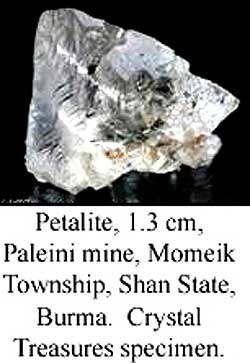 Now I would like to correct an unjust negative comment about a website I made in the last report. Actually I had mostly good things to say about the new site called Crystal Treasure (www.crystal-treasure.com), run, I’m told, by a German who goes regularly to Myanmar (Burma) and travels back roads by bicycle in an effort to scare up motley gem crystals in the famous Mogok Gem Tract and elsewhere in the mysterious country (where the repressiveness of a xenophobic, crypto-fascist government, sad to say, still prevails). The Crystal Treasure website is dormant just at the moment, as its proprietor is pedaling hard even now in the Burmese bush, but look in anyway and you’ll see an intriguing leftover selection of little loose crystals and clusters, not only of the predictable spinel, phenakite, topaz, elbaite, goshenite beryl, etc., but also of euhedral and gemmy enstatite, danburite, sinhalite, epidote, hambergite, petalite, and many more (see, as a teaser, the picture of a complete, 1.3-cm petalite crystal here). In my earlier note I complained that the pictures are too small for maximum appreciation, and that specific localities are not given. But no, if you click on individual specimen pictures you’ll get greatly enlarged images, and, besides, a little informational chart for each specimen giving, among other things, detailed and precise provenance information. Without qualification this time, I recommend this site highly as, at the least, a rich source of information about the exotic products of the Mogok Gem Tract.
Now I would like to correct an unjust negative comment about a website I made in the last report. Actually I had mostly good things to say about the new site called Crystal Treasure (www.crystal-treasure.com), run, I’m told, by a German who goes regularly to Myanmar (Burma) and travels back roads by bicycle in an effort to scare up motley gem crystals in the famous Mogok Gem Tract and elsewhere in the mysterious country (where the repressiveness of a xenophobic, crypto-fascist government, sad to say, still prevails). The Crystal Treasure website is dormant just at the moment, as its proprietor is pedaling hard even now in the Burmese bush, but look in anyway and you’ll see an intriguing leftover selection of little loose crystals and clusters, not only of the predictable spinel, phenakite, topaz, elbaite, goshenite beryl, etc., but also of euhedral and gemmy enstatite, danburite, sinhalite, epidote, hambergite, petalite, and many more (see, as a teaser, the picture of a complete, 1.3-cm petalite crystal here). In my earlier note I complained that the pictures are too small for maximum appreciation, and that specific localities are not given. But no, if you click on individual specimen pictures you’ll get greatly enlarged images, and, besides, a little informational chart for each specimen giving, among other things, detailed and precise provenance information. Without qualification this time, I recommend this site highly as, at the least, a rich source of information about the exotic products of the Mogok Gem Tract.
China section! First I will pass on the vague intelligence, now being heard from several quarters, that the Daoping mine, Guilin, Guangxi Province, is once again producing superb pyromorphite specimens. Up to now the rumor has been that we can expect no more gleaming, world-beating pyromorphites such as briefly flooded the market a few years ago, and, sure enough, we’ve seen nothing but remainders for several show cycles now. But Dan Weinrich, for one, has just acquired what he says is a newly mined batch, many of the fresh pieces consisting of parallel groups of lustrous, elongated, bright green, hoppered crystals. The usual utterances of optimistic hope are in order, but no details are at hand as yet…
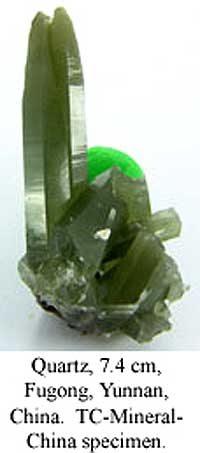 …no, not even from Mr. Chen Weigang of TC-Mineral-China (www.mineral-china.cn or www.china-mineral.cn), who nevertheless is still adding new things constantly to his superabundant website (mentioned more than once before in this space). Look in now and you’ll find some appealing specimens of what Mr. Chen calls “actinolite quartz” very recently dug in a lead-zinc mine at a place called Fugong, Yunnan Province. The specimens are loose, single crystals or clusters of two or three, some of the latter showing crude brown axinite crystals around their bases. The “actinolite quartz” prisms are very thin, and taper to points; they are lustrous, and colored a pleasant opaque grayish green, presumably by included hedenbergite or by (why not?) actinolite. Individual spiky crystals reach more than 10 cm long. Except for their mirror-smooth faces these crystals closely resemble the well known hedenbergite-included quartz crystals from Seriphos, Greece or from the Italian island of Elba.
…no, not even from Mr. Chen Weigang of TC-Mineral-China (www.mineral-china.cn or www.china-mineral.cn), who nevertheless is still adding new things constantly to his superabundant website (mentioned more than once before in this space). Look in now and you’ll find some appealing specimens of what Mr. Chen calls “actinolite quartz” very recently dug in a lead-zinc mine at a place called Fugong, Yunnan Province. The specimens are loose, single crystals or clusters of two or three, some of the latter showing crude brown axinite crystals around their bases. The “actinolite quartz” prisms are very thin, and taper to points; they are lustrous, and colored a pleasant opaque grayish green, presumably by included hedenbergite or by (why not?) actinolite. Individual spiky crystals reach more than 10 cm long. Except for their mirror-smooth faces these crystals closely resemble the well known hedenbergite-included quartz crystals from Seriphos, Greece or from the Italian island of Elba.
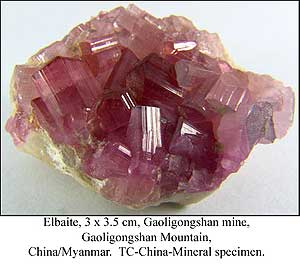 Also starring now on the TC-Mineral-China site are some miniature and small cabinet-size specimens showing tight clusters of short-prismatic crystals of “tourmaline” (probably elbaite) resting on quartz crystals or on matrix chunks of orthoclase. The tourmaline crystals reach 2 cm, and they are lustrous, part-gemmy, and a very pretty medium-pink, with a few appearing to sport extremely thin blue “caps” at their terminations. Their locality as given on the site is simply “Yunnan,” but upon inquiry I learn from Mr. Chen that all hail from the Gaoligangshan mine, a digging of unspecified type in Gaoligangshan mountain, near the China/Myanmar border. They are winning and promising-looking specimens, as the picture here will attest.
Also starring now on the TC-Mineral-China site are some miniature and small cabinet-size specimens showing tight clusters of short-prismatic crystals of “tourmaline” (probably elbaite) resting on quartz crystals or on matrix chunks of orthoclase. The tourmaline crystals reach 2 cm, and they are lustrous, part-gemmy, and a very pretty medium-pink, with a few appearing to sport extremely thin blue “caps” at their terminations. Their locality as given on the site is simply “Yunnan,” but upon inquiry I learn from Mr. Chen that all hail from the Gaoligangshan mine, a digging of unspecified type in Gaoligangshan mountain, near the China/Myanmar border. They are winning and promising-looking specimens, as the picture here will attest.
 The Imiter silver mine, Ouarzazate Province, Morocco, has lately poured forth generous numbers of very unusual-looking (and, at their best, superlative) specimens of acanthite; much less generously the mine also yields good wire silver specimens and even some nice, though small, crystal clusters of bright red proustite. In early 2004 a small but significant strike of chlorargyrite occurred somewhere in the Imiter mine, and eight pretty specimens are now available from Ian Bruce of Crystal Classics: you may reach him most easily via the MinVision site (www.minvision.com) shared by Crystal Classics and Kristalle. Not even at the old classic localities for chlorargyrite (of which the best are Broken Hill, Australia and the Erzgebirge region of Germany) does the species form crystals as large as 1 cm, and at the Imiter mine, too, individuals only reach 3 mm or so. But these specimens manage to be impressive anyway, as the highly lustrous, translucent, yellow-orange to lime-green chlorargyrite crystals form solid druse coverages to several centimeters across on matrix of earthy brown “limonite” and weathered galena. A small cabinet-size one of these specimens (the largest matrix on hand with Ian measures 4 × 7 × 8 cm) would probably represent your best chance at adding a good, pretty specimen of the elusive silver chloride to your collection.
The Imiter silver mine, Ouarzazate Province, Morocco, has lately poured forth generous numbers of very unusual-looking (and, at their best, superlative) specimens of acanthite; much less generously the mine also yields good wire silver specimens and even some nice, though small, crystal clusters of bright red proustite. In early 2004 a small but significant strike of chlorargyrite occurred somewhere in the Imiter mine, and eight pretty specimens are now available from Ian Bruce of Crystal Classics: you may reach him most easily via the MinVision site (www.minvision.com) shared by Crystal Classics and Kristalle. Not even at the old classic localities for chlorargyrite (of which the best are Broken Hill, Australia and the Erzgebirge region of Germany) does the species form crystals as large as 1 cm, and at the Imiter mine, too, individuals only reach 3 mm or so. But these specimens manage to be impressive anyway, as the highly lustrous, translucent, yellow-orange to lime-green chlorargyrite crystals form solid druse coverages to several centimeters across on matrix of earthy brown “limonite” and weathered galena. A small cabinet-size one of these specimens (the largest matrix on hand with Ian measures 4 × 7 × 8 cm) would probably represent your best chance at adding a good, pretty specimen of the elusive silver chloride to your collection.
 The Italian dealership called Webmineralshop (www.webmineralshop.com) has come up with a couple of new, interesting if unspectacular mineral finds. Two old, now merged, open-pit workings in limestone called the Limberg and Skräbböle quarries lie near the town of Parainen, southwestern Finland, just across the Baltic Sea from Stockholm. Recently in the Skräbböle quarry a Finnish collector dug some cabinet-size specimens consisting mainly of sharp, blocky, opaque gray-white crystals of meionite (one of the scapolite group) and lustrous, prismatic gray-green diopside crystals. Both species, all right, are plain-looking, but the largest meionite crystal found measures 15 cm, and the largest diopside measures 11 cm, and these specimens constitute fine examples of both minerals. Also in the Skräbböle quarry, in 2004 and 2005, a few specimens showing terminated prisms of opaque, bright blue fluorapatite to 6 cm long, embedded in cleavable white calcite with massive dark purple fluorite, were found, and these also are available on the Webmineralshop site. Then, on the same site, there are new specimens showing green, part-gemmy diopside crystals in feathery-looking clusters to 5 cm or so, from a place called Chipata, Zambia—the Webmineralshop people could offer no further information about this latter occurrence and neither, therefore, can I.
The Italian dealership called Webmineralshop (www.webmineralshop.com) has come up with a couple of new, interesting if unspectacular mineral finds. Two old, now merged, open-pit workings in limestone called the Limberg and Skräbböle quarries lie near the town of Parainen, southwestern Finland, just across the Baltic Sea from Stockholm. Recently in the Skräbböle quarry a Finnish collector dug some cabinet-size specimens consisting mainly of sharp, blocky, opaque gray-white crystals of meionite (one of the scapolite group) and lustrous, prismatic gray-green diopside crystals. Both species, all right, are plain-looking, but the largest meionite crystal found measures 15 cm, and the largest diopside measures 11 cm, and these specimens constitute fine examples of both minerals. Also in the Skräbböle quarry, in 2004 and 2005, a few specimens showing terminated prisms of opaque, bright blue fluorapatite to 6 cm long, embedded in cleavable white calcite with massive dark purple fluorite, were found, and these also are available on the Webmineralshop site. Then, on the same site, there are new specimens showing green, part-gemmy diopside crystals in feathery-looking clusters to 5 cm or so, from a place called Chipata, Zambia—the Webmineralshop people could offer no further information about this latter occurrence and neither, therefore, can I.
To wrap up this report we will return to Colorado and to the Collector’s Edge dealership—this time with a hat-tip also to Bob Stouffer’s Colorado Minerals (www.coloradominerals.com). At the upcoming 2007 Denver Show, both dealerships’ booths in the Denver Merchandise Mart (the “Main Show”) will be offering pieces from a March 2007 discovery of creedite in the Henderson mine (the world’s largest molybdenum mine), Empire, Clear Creek County, Colorado. Sparkling, pale lilac druses of creedite microcrystals form wide coverages on brown, brecciated matrix; in some cases the creedite crusts form aesthetic hemispherical aggregates to 7 mm in diameter. Available specimens range from thumbnail to cabinet size.
Now don’t tell me I didn’t give you reasons to make it to this Denver Show. I think, by gum, I just might make it there myself. Until then, over and out, and Stay Cool.
For questions about this column, please email Tom Moore.
